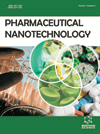- Home
- A-Z Publications
- Pharmaceutical Nanotechnology
- Previous Issues
- Volume 5, Issue 4, 2017
Pharmaceutical Nanotechnology - Volume 5, Issue 4, 2017
Volume 5, Issue 4, 2017
-
-
Application of Chitosan and its Derivatives in Nanocarrier Based Pulmonary Drug Delivery Systems
More LessBackground: The respiratory tract as a non-invasive route of drug administration is gaining increasing attention in the present time on achieving both local and the systemic therapeutic effects. Success in achieving pulmonary delivery, requires overcoming barriers including mucociliary clearance and uptake by macrophages. An effective drug delivery system delivers the therapeutically active moieties at the right time a Read More
-
-
-
Vesicular Systems Containing Curcumin and Their Applications in Respiratory Disorders – A Mini Review
More LessBackground: Vesicular systems like nanotechnology and liposomes are gaining tremendous attention lately in the field of respiratory diseases. These formulations enhance bioavailability of the drug candidate, which could be achieved through a novel drug delivery mechanism. Moreover, the therapeutic potential achieved through these systems is highly controllable over long durations of time providing better efficacy and Read More
-
-
-
An Appraisal on Various Methods of Nano Particulate Formulations
More LessAuthors: Bindu Dhiman, Divtrannum, Anju Dhiman and Sapna SainiBackground: Nanotechnology has immense significance in the field of medicine, agriculture, business, public health sector due to wide applicability of the nano products. Basically, nanotechnology is the incorporation of nanoscale structures into larger material components to improve the properties of constructed system. Method: Nanotechnology serves as an alternative drug delivery system to the liposomes drug delivery Read More
-
-
-
A Comprehensive Review on Role of Nanoparticles in Therapeutic Delivery of Medicine
More LessAuthors: Sandeep Rathor, D.C Bhatt, Sheikh Aamir, S.K. Singh and Vikash KumarBackground: The effective targeted drug delivery system is significant for future development of medicinal product and healthcare. There are also different types of nanostructures which include solid lipid nanoparticles, liposomes, dendrimers, nanostructured lipid carriers, lipid drug conjugate, liquid crystalline particles, polymeric nanocrystals, polymeric nanoparticles and superparamagnetic nanoparticles which have been cons Read More
-
-
-
Physicochemical Modifications and Nano Particulate Strategies for Improved Bioavailability of Poorly Water Soluble Drugs
More LessAuthors: Komal Siddiqui, Abdul Waris, Habiba Akber, Kinza Munir, Maria Mir, Muhammad W. Khan, Waqar Aman and Fakhar-ud-DinBackground: Bioavailability is the segment of dose that is bioavailable for its therapeutic effect on the systemic circulation without any change in its characteristics, after administration by either route. It is one of the fundamental pharmacokinetic properties of drugs. It is important because, it defines the amount of drug to be administered for its intended therapeutic effect. If drug is more bioavailable, less amount of it is requir Read More
-
-
-
A Self-nanoemulsifying Drug Delivery System for Poorly Water Soluble Tolbutamide: Development, Optimization and Pharmacodynamic Studies
More LessAuthors: Deepti Pandita, Neelam Kumari and Viney LatherBackground: Self-nanoemulsifying drug delivery system (SNEDDS) has immense potential in oral bioavailability enhancement of lipophilic drugs. Objective: This investigation involves the development of thermodynamically stable and dilutable SNEDDS for tolbutamide, for achieving higher water solubility and enhanced dissolution rate which in turn improves its oral bioavailability. Method: Preliminary solubility studies were c Read More
-
-
-
Development and Characterization of Gefitinib Loaded Polymeric Nanoparticles by Ionic Gelation Method
More LessAuthors: Minakshi Gupta, Rakesh K. Marwaha and Harish DurejaBackground: There is a rapidly growing interest in the development of nanoparticle drug delivery mainly for anticancer drugs as it promises to solve several problems associated with anticancer drugs such as poor water solubility, low therapeutic index, nonspecific distribution and higher systemic toxicity, etc. Objective: The objective of the study was to investigate the effect of various critical variables like, concentration of chitosan Read More
-
-
-
Design, Optimization and Characterization of Granisetron HCl Loaded Nano-gel for Transdermal Delivery
More LessAuthors: Geeta Aggarwal, Vikash Kumar and Hema ChaudharyBackground & Objective: Our research objective was to design, develop, optimize and characterize Granisetron HCl transdermal gel in order to minimize side effects associated with oral delivery. Method: A statistical design was practically applied for further optimization and preparation of transfersomal gel using Box-Behnken methodology at three levels. The selected independent and dependent variables were Lipoid, surf Read More
-
-
-
Formulation and Evaluation of Novel Solid Lipid Microparticles for the Sustained Release of Ofloxacin
More LessAuthors: Aashima Hooda, M. Sradhanjali and PopsyObjective: The aim of this study was to prepare solid lipid microparticles (SLM) with incorporated ofloxacin, suitable for oral delivery. Methods: Ofloxacin-loaded SLM were prepared using stearic acid and chloroform as lipid matrix and Tween-80 as surfactant, by high shear homogenization technique and followed by lyophilization. The physiochemical characterization of SLMs were investigated by scanning electron microsco Read More
-
Most Read This Month
Article
content/journals/pnt
Journal
10
5
false
en


